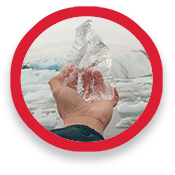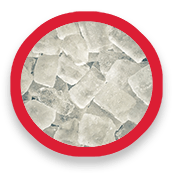SCIENCE EXPERIMENTS FOR KIDS
HOW TO EXPLORE MELTING ICE
This cool experiment with frozen water will have your kids singing ice, ice baby


Tested, edited & approved by:
Beth Kracum,
Former Science Educator
This animal is not on exhibit in the habitats. It is one of our Animal Ambassadors and is used in public and school programs.
This cool experiment with frozen water will have your kids singing ice, ice baby
Ice. It’s not just the theme of a pseudo-rap song from the 90’s. In this experiment, your kids can come out of the cold and explore this common freezer staple.
Whatever the weather outside or song stuck in your head, your child will have tons of fun with this icy investigation. Using just a bit of water, your freezer and found objects from around the house, they can melt away the hours learning about solids, liquids and the properties of water.
GATHER THIS:
- Wide-mouthed container that can hold 1-2 cups water (old sour cream tubs or yogurt containers are ideal)
- Water-tight tub, bowl, or baking pan
- Cup of tap water
- Cup of hot water
- Metal objects (e.g. bolts, washers, spoons, pennies, copper pipe)
- Wooden objects (e.g. craft sticks, toothpicks)
- Table salt
- Optional: Thermometer, food coloring, other materials for testing such as rocks, plastic toys, anything smaller than your hand that you don’t mind getting wet!
THEN DO THIS:
- Ahead of time: Fill the plastic container with water and freeze overnight to create a giant ice cube. The water will expand as it freezes, so leave a little space in the container!
- Transfer the giant ice cube to a tub, bowl, or baking pan for exploration.
- Encourage your child to use their senses to touch, smell, listen, and look at the ice cube.
- Give your child a selection of tools to explore the ice. Encourage them to try different experiments, like holding the tool on the ice and counting to twenty or putting two tools next to each other on the ice to compare the results.
ASK THIS:
- Which tool works best to melt the ice?
- What do you predict will happen when you use [any tool] on the ice?
- How does your ice look, sound, or smell different after using a tool?
- What happens to the tool after you have been using it on the ice?
WHAT IS HAPPENING?
Some materials are better at conducting energy than others! Metals like copper and steel are great at moving the heat from the air or your hand into the ice. Wood is a better insulator; it holds onto energy better than metals. Salt melts ice by chemically lowering the freezing point of water. While fresh water freezes at 32 degrees Fahrenheit (0 degrees Centigrade), salt water must be colder!
WHAT THIS TEACHES:
Skills: Cause & effect; observation; comparison
Themes: States of matter, energy
Join the CuriOdyssey Community
LOCATION
1651 Coyote Point Drive
San Mateo, CA 94401
Ohlone Land Acknowledgement
650-342-7755
info@curiodyssey.org
CuriOdyssey is a 501(c)(3) non-profit, Tax ID 94-1262434


